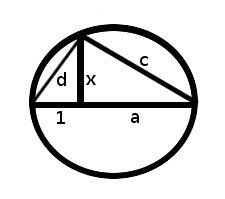In the previous post on this topic I showed that it is possible to solve some simple equations using only geometry. In this post I intend to talk about how geometry can be used to solve equations from the second degree.
Before talking about some specific equations, lets try to understand how somebody from ancient Greece would look on them. We are very used to see expressions of the form x^2+x. What it means for us is that we take a number, square it and add to itself to get a new number. But for someone from the ancient world this would be meaningless. For him x was a length and x^2 was area. Since it is not possible to add length and area, such expression would be meaningless to him. From this come the following series of rules:
1. In an equation all the "variables" must be of the same "type" - all of the things we want to add must all be either length or area.
2. Multiplying two numbers is creating a rectangle.
3. Square root can be taken only from are, and the result will be length.
Lets try to prove an algebraic identity geometrically. The identity is a simply one:
 This is the full proof. The left side of the equation is the area of the square, and the right side is the sum of all the little squares and rectangles that the square is divided in.
This is the full proof. The left side of the equation is the area of the square, and the right side is the sum of all the little squares and rectangles that the square is divided in.We no longer use this method to proof this identity, but it is the easiest to visualize method.
An important side effect of this proof is that we now know how to take square roots from expressions of the form a^2+2ab+b^2. So lets use this knowledge to calculate something. The following is a simple second degree equation:
Since we want to use geometry, 4 and nine are rectangles with the area of 4 and nine. If we will add 5 to both sides, we will get:
But this is exactly of the correct form for the identity we just proved... We just need to use it, and we will get that:
Now we can take the square root, and get:
To get the solution, I used geometry only in the proof of the identity I used. However, what I did manipulating with symbols, an ancient Greek mathematician would do moving squares. Since it is not easy to draw such process, I decieded to only mention it. It is easy to see what Geometrical action stands behind each one of the algebraic manipulations. For a general second degree polynomial, we can just complete one side to a square, and then follow the same principal.
The ancient Greeks saw x^2 as a two dimensional object, but we don't this. To be more precise, this is still doe in physics where numbers come with units, but not in math. Why is so? Is it right to claim that x^2 is of the same sort as x? Surprisingly it is. It is possible, for example, to take the square root of "length" and get "length" back. We can do all the operations on numbers without ever leaving the real line. There is no need for a two dimensional space to achieve this (it is needed only for imaginary numbers). This was proven be Descartes. I will not do all the proofs here, only the one about square roots.
Suppose we have anon zero positive number a. We want to construct a line with the length

Now to the proof. All the triangles are right triangles so we can use the Pythagoras theorem:
a^2+2x^2+1=1+2a+a^2
2x^2=2a
x^2=a







No comments:
Post a Comment